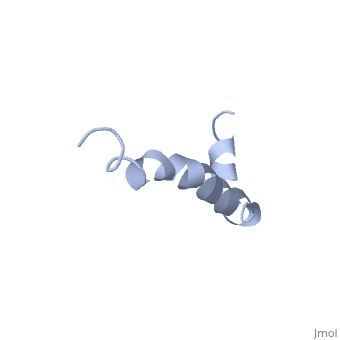Amyloid beta
From Proteopedia
(Difference between revisions)
| Line 1: | Line 1: | ||
<StructureSection load=1iyt size='500' side='right' caption='amyloid-beta(1-42)', ([[1dm0]])' scene=''> | <StructureSection load=1iyt size='500' side='right' caption='amyloid-beta(1-42)', ([[1dm0]])' scene=''> | ||
==Introduction== | ==Introduction== | ||
| - | '''Alzheimer's disease''' is characterized by extracellular proteic plaques and intracellular neurofibrillary tangles.<ref name="structure">PMID: 12423364</ref> These plaques are collections of beta-amyloid <scene name='Amyloid_beta/Fibrils/1'>fibrils</scene> of aggregated beta-sheets. When amyloid beta comes into contact with metal ions and oxygen the result is the production of reactive oxygen species (especially hydrogen peroxide).<ref name="alz">PMID:18305836</ref> Amyloid beta also maintains the capacity to to induce pore formation in neuronal and endothelial cells which can trigger cell death.<ref name="structure" /><ref name="alz" /> Yet another source of amyloid beta toxicity stems from its ability to induce endothelial cell damage through the production of superoxide, though the mechanism of such induction is unclear.<ref name="alz" /> | + | '''Alzheimer's disease''' is characterized by extracellular proteic plaques and intracellular neurofibrillary tangles.<ref name="structure">PMID: 12423364</ref> These plaques are collections of beta-amyloid <scene name='Amyloid_beta/Fibrils/1'>fibrils</scene> of aggregated beta-sheets. When amyloid beta comes into contact with metal ions and oxygen the result is the production of reactive oxygen species (especially hydrogen peroxide).<ref name="alz">PMID:18305836</ref> Amyloid beta also maintains the capacity to to induce pore formation in neuronal and endothelial cells which can trigger cell death.<ref name="structure" /><ref name="alz" /> Yet another source of amyloid beta toxicity stems from its ability to induce endothelial cell damage through the production of superoxide, though the mechanism of such induction is unclear.<ref name="alz" /> While the presence of the fibril plaques remains a marker for Alzheimer's disease recent studies have suggested that alymoild beta oligomers more devestating effect occurs when it impairs long-term potentiation which decreases dendritic spine density in the hippocampal brain and impairs memory.<ref name="recent">PMID:22114742</ref> |
==Structure== | ==Structure== | ||
Revision as of 00:44, 29 November 2011
| |||||||||||

